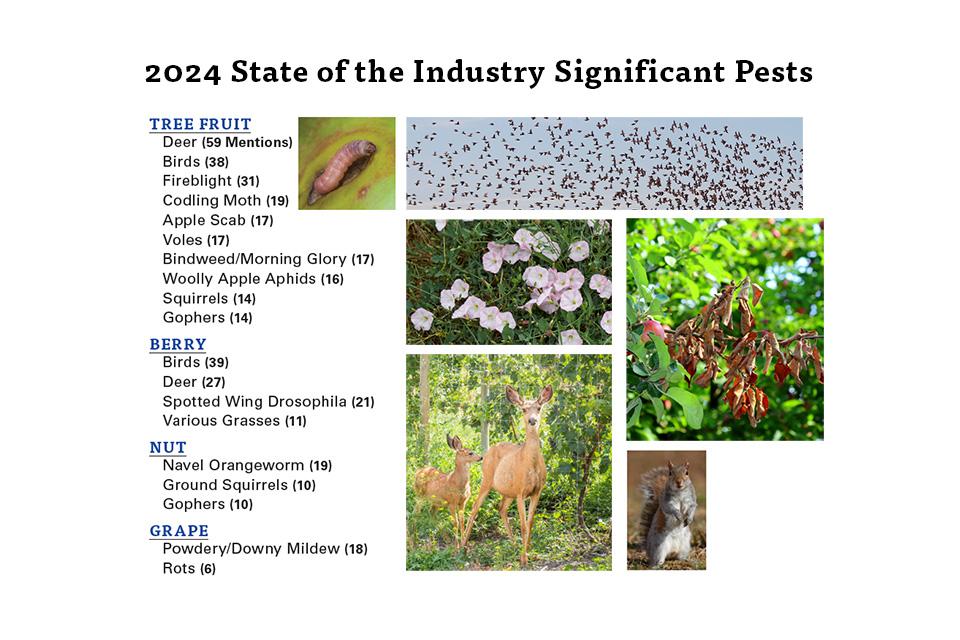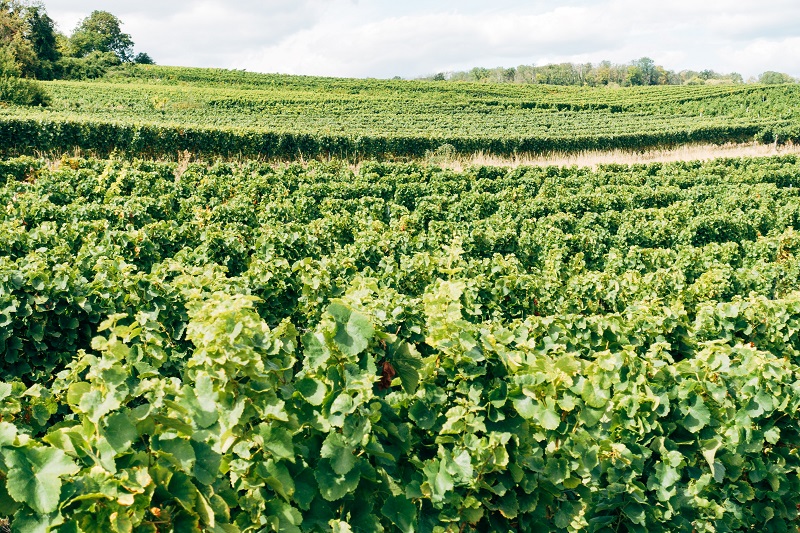Survey Results Show Biggest Pest Problems For Fruit Growers Right Now
Regardless of pest type — weeds, disease, insects or wildlife — wet weather exacerbated fruit and nut grower problems from coast to coast in 2023, particularly in California, where years of drought ended emphatically.
WEEDS
Regarding weeds, more rain combined with less herbicide is making life more difficult for growers.
A Massachusetts tree fruit grower sums up the issue perfectly, saying, “Our weeds grew like weeds this season, with heavy rains and herbicide wash-out.” A fellow apple grower in the state confers, noting that weeds of all types were prevalent because of over-hydration issues.”
On the other side of the country, California growers for the most part welcomed the rains of the 2022-2023 offseason. Unfortunately, so did the weeds. “In general, rain caused more weeds,” a table grape grower says.
A New York apple grower, plagued by perennial ryegrass in his tree rows, laments herbicide restrictions. “This is what happens when you stop using glyphosate and paraquat,” he says. “Eventually you need them again.”
“The elimination of herbicides makes it harder to control all weeds,” a California berry grower concurs.
Cost-related cuts in labor are hurting, too. “Pigweed, bindweed, nutgrass — frankly, we didn’t handle it very well without the labor to keep the weeds in control,” a Tennessee berry grower says. “Spraying once the crop is of a certain size isn’t an option.”
“Most of (the weeding) was going to be done by someone else and was not,” an Ohio wine grape grower says. “I did the weed control and mowing.”
DISEASE
Rain-induced diseases are cited by many growers, staring with a California olive grower who notes a small controlled and treated outbreak of olive knot disease, likely caused by rains entering tree wounds in the spring.
A California apple grower experienced fire blight because of the wet spring. “Prune, prune, prune,” he says. “Keep cutting it out.”
“With the wet winter, we had a higher incidence of a fungus infection, so we had to spend more money on chemicals and labor to protect the fruit,” a California stone fruit grower adds.
The East and Southeast experienced similar issues. “Very much rain — many diseases,” a Maine pome fruit grower says. “We had to spray more than we have ever sprayed,” an Alabama berry grower says.

INSECTS
Wet weather affected the control of thrips in California, a citrus grower says. Several other growers in that state and Oregon single out the insect. “We had some crop loss,” an Oregon stone fruit says. “Thrips were a big issue,” another California citrus grower says.
On the other side of the country, woolly apple aphids rose to prominence among regional apple growers. “Woolly apple aphid was a huge issue, with limited available options for containing the problem,” a New York state grower says. Finding an integrated pest management approach that works is at issue, according to another apple grower in the state. Meanwhile, growers in Pennsylvania and Indiana also saw an increase in the insect.
Japanese beetles continue to be a problem for tree fruit growers, with mixed results against them. “We have not been able to get a handle on the beetles,” a Vermont pome fruit grower says. “Pheromone traps helped a little,” a Virginia stone fruit grower adds. With better luck is a Wisconsin stone fruit grower. “We do saturation trapping, meaning we put out about 10 or 12 traps per acre,” he says. “It’s very effective.”
A Minnesota apple grower with codling moth issues reminds his peers of the importance of timely treatments. “One of my sprays must have been off slightly,” he says. “By the time I realized it, it was too late.”
WILDLIFE
Rodents will “take over the world” when humans are gone, says one apple grower in California. Until that day arrives, fellow fruit growers across the country are hellbent on protecting their borders with fencing.
In Michigan, a grower now surrounds his 5-acre strawberry field with an 8-foot fence to ward off deer. In Virginia, a grower uses fencing and tree guards to prevent deer and cattle from damaging his apple and pear trees. A New Hampshire pome fruit grower fences his whole orchard to stop pigs. “Deer eating our crops has always been an issue for us, so we put up deer fence around our gardens and will put up more this year,” a Pennsylvania blueberry grower says.
Just the same, many survey respondents, such as a grape grower in Texas, are turning to netting for protection against smaller animals and birds. “Birds ate all our blueberries and red raspberries,” a Missouri grower says, noting he is now turning to total netting of his blueberries in 2024.
Meanwhile, “hunters are welcomed,” a Washington state berry grower says, echoing the sentiment of many peers, whether the culprits have four legs or two wings. Birds have become an issue in Oregon, “but we send in the people at that point,” a blueberry grower says.
Berry farmers in Idaho, Texas, and Michigan have been less fortunate thus far. A Washington state apple grower singles out starlings, estimating they ruined 10% to 15% of his crop. “Waxwing birds were REALLY bad,” a Florida berry grower adds. “They wiped out one-quarter of our crop.”
Gophers are now a serious issue in California due to last year’s rains. “Gophers are eating the roots and killing small trees,” one of the state’s pecan growers says. A California grower of stone fruit has turned to planting new trees in gopher baskets.
The problem is even more prickly in Texas, where another stone fruit grower says porcupines have become a greater problem.










